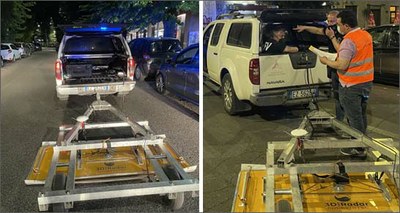Environment: Hi-tech solutions, innovative radars and sensors for sinkhole risk mitigation in cities
30/9/2021
 Preventing sinkholes and landslides that endanger citizens and the territory thanks to a set of advanced technologies - radars, innovative sensors, geophysical prospecting - capable of analyzing the subsoil under roads and public parks and detecting possible cavities up to 3-4 meters below the surface. This is the goal of the project MUSE (Multi-sensor Services), conducted by ENEA jointly with the INGV, Consorzio Hypatia, the companies Superlectric, Ylichron, G-Matics, which specifically pursues the creation of an analysis protocol for urban areas and their geomorphological anomalies, through satellite, drone or aircraft surveys and the use of state-of-the-art geophysical techniques to study the first subsoil, like multifrequency georadar and capacitive geoelectrics.
Preventing sinkholes and landslides that endanger citizens and the territory thanks to a set of advanced technologies - radars, innovative sensors, geophysical prospecting - capable of analyzing the subsoil under roads and public parks and detecting possible cavities up to 3-4 meters below the surface. This is the goal of the project MUSE (Multi-sensor Services), conducted by ENEA jointly with the INGV, Consorzio Hypatia, the companies Superlectric, Ylichron, G-Matics, which specifically pursues the creation of an analysis protocol for urban areas and their geomorphological anomalies, through satellite, drone or aircraft surveys and the use of state-of-the-art geophysical techniques to study the first subsoil, like multifrequency georadar and capacitive geoelectrics.
"These technologies enable us to perform a sort of "ultrasound" of the subsoil that provides different levels of detail, to detect the possible presence of voids of different origin and subsidence of the soil due to the emergence of underground cavities, so-called "collapse chimneys", precursors of the formation of actual surface sinkholes. The technologies used, also supported by the analysis of satellite data, range from instrumental in-situ investigations to integrated indirect investigations ", explained Vittorio Rosato and Stefano Urbini, project coordinators for ENEA and INGV.
"Sinkholes formation, often associated with electrical and electromagnetic anomalies of the subsoil, threaten our cities, also due to an intense urban growth occurred in the last century", pointed out Vittorio Rosato, head of the ENEA Analyses and Protection of Critical Infrastructures Laboratory. "Rome is a typical case of a complex underground structure that requires investigations and monitoring of the territory, to verify the possible presence of geophysical anomalies related to anthropogenic cavities reaching the surface".
Upon request by the Civil Protection of Rome Capital, with whom a collaboration is in place, the activities of the project are focusing on the analysis of the urban subsoil, to prevent the formation of new anthropogenic sinkholes caused by ancient cavities present in the subsoil reaching the surface (pozzolana quarries, tuffs, sand, catacombs and hypogea, etc.) or as a result of failures and damage of underground utilities (sewage and water systems).
"The Civil Protection has been constantly engaged in monitoring the subsoil of the city through direct exploratory investigations of underground cavities and, in particular, of areas known to be prone to sinkholes due to their geological and archaeological characteristics.
The technical support of public and private research is crucial since it provides the Capitoline Administration with quality technological standards with which to conduct activities for the prediction and prevention of these phenomena, which greatly worry citizens and are often difficult to predict, as they are not preceded by precursor events ", pointed out Gianluca Ferri, geologist and head of the Geological and Geomorphological Risk Office of the Rome Security and Civil Protection Department.
The project MUSE is one of the 7 projects of the LAreospaZIO call which aims to increase the opportunities for technological development of companies in the aerospace sector through new associations with universities and public and private research centers, with significant scientific and technological skills also at an international level. LAreospaZIO, led by ENEA in the role of Mandatory Research Organism, comprises 15 partners and is funded by the Lazio Region as part of the “Strategic Projects” call for 2019.
For more information please contact:
Vittorio Rosato, ENEA - Head Laboratory Analyses and Protection of Critical infrastructures, vittorio.rosato@enea.it
Competition announcement LAreospaZIO: https://www.laerospazio.enea.it

